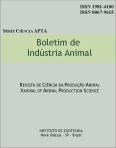The control of biological activity of PMFSG in superovulated embryo donors cows
Keywords:
PSMG, anti-PSMG, superovulation, embryo, dairy cowAbstract
Thirty four Friesian cows located in two properties were superovulated between 8 and 12 days after the oestrus by injecting 2500 UI of PMSG (Pregnant Mare Seruni Gonadotrophin) (n = 21) or 32 mg FSH-P (Folicle Stimulant Hormone Pitintary) (n = 13) in decreasing doses. Fourty eight hours later a luteolitic injection of cloprostenol was given. The cows were inseminated by artificial insemination (AI) at the begining and at the end of the oestrus. At the time of the first AI, ten cows treated with PMSG were given 2 ml anti-PMSG ovine antiserum. The ovarian response was evaluated day 7 (day Ø = AI) by counting the number of corpora lutea, follicles and the number and quality of the embryos collected nonsurgically. It was not observed significant difference in the number of corpora lutea, follicles and in the number of embryos, but the percentage of transferable embryos was similar for the anti-PMSG (68,9%) and FSH-P (81.5%) treatments, both greater (P<0.05) than the treatment without the anti-PMSG (24,6).Downloads
Downloads
Published
Issue
Section
License
Os autores não serão remunerados pela publicação de trabalhos, pois devem abrir mão de seus direitos autorais em favor deste periódico. Por outro lado, os autores ficam autorizados a publicar seus artigos, simultaneamente, em repositórios da instituição de sua origem, desde que citada a fonte da publicação original seja Boletim de Indústria Animal. A revista se reserva o direito de efetuar, nos originais, alterações de ordem normativa, ortográfica e gramatical, com vistas a manter o padrão culto da língua e a credibilidade do veículo. Respeitará, no entanto, o estilo de escrever dos autores. Alterações, correções ou sugestões de ordem conceitual serão encaminhadas aos autores, quando necessário. Nesses casos, os artigos, depois de adequados, deverão ser submetidos a nova apreciação. As opiniões emitidas pelos autores dos artigos são de sua exclusiva responsabilidade. Todo o conteúdo deste periódico, exceto onde está identificado, está licenciado sob a Licença Creative Commons Attribution (CC-BY-NC). A condição BY implica que os licenciados podem copiar, distribuir, exibir e executar a obra e fazer trabalhos derivados com base em que só se dão o autor ou licenciante os créditos na forma especificada por estes. A cláusula NC significa que os licenciados podem copiar, distribuir, exibir e executar a obra e fazer trabalhos derivados com base apenas para fins não comerciais.













